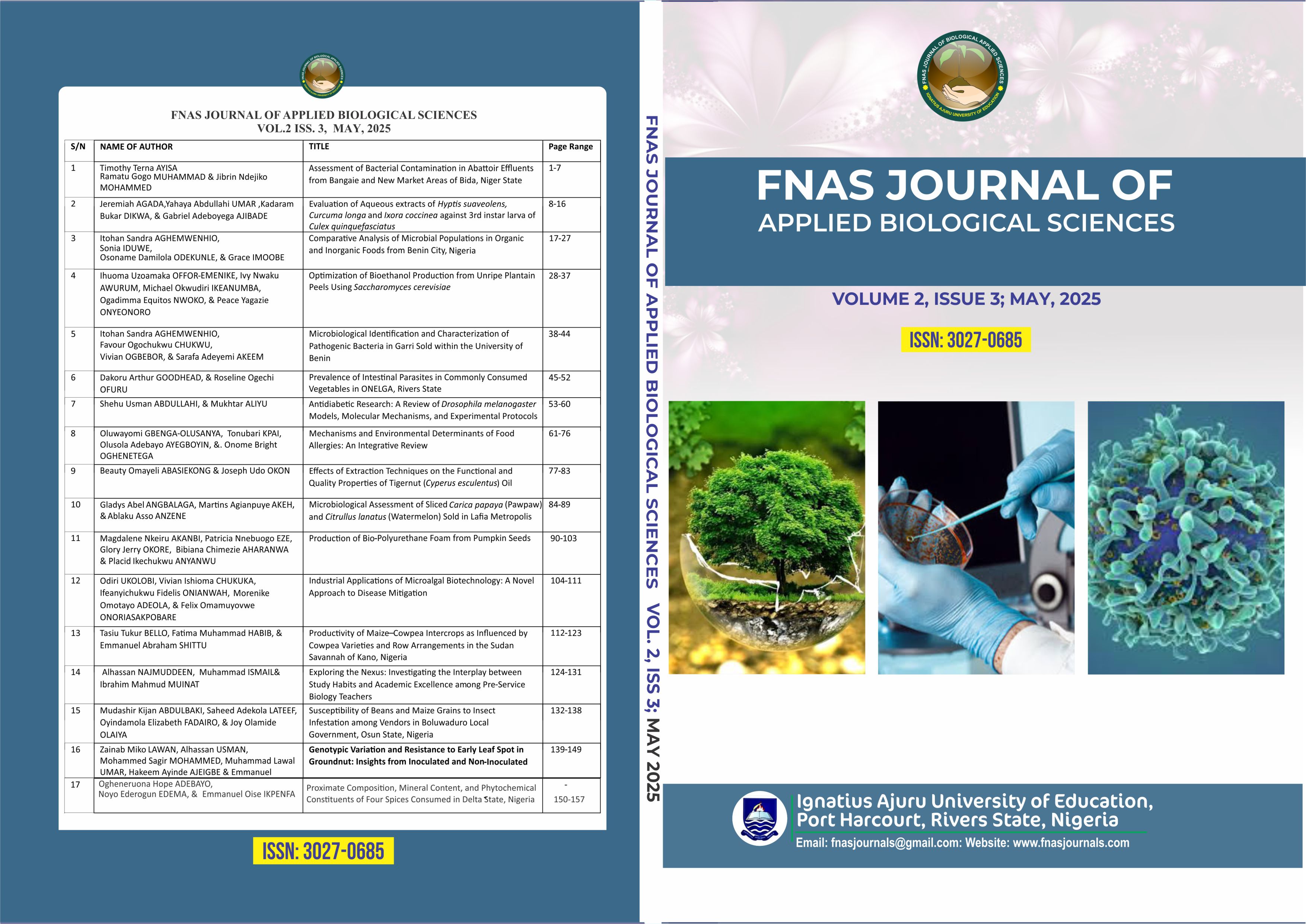Effects of Extraction Techniques on the Functional and Quality Properties of Tigernut (Cyperus esculentus) Oil
DOI:
https://doi.org/10.63561/jabs.v2i3.935Keywords:
Effect, Mechanical, Chemical, Tigernut oil, Quality properties, ExtractionAbstract
This research studied the functional quality of oil extracted from Tiger nut using two different methods (Mechanical extraction and Chemical solvent extraction methods) and the results revealed Moisture: 0.394 ± 0.0021 and 0.226 ± 0.0077, Fatty acid; 0.408 ± 0.0098 and 0.311 ± 0.0005, Impurity; 0.045 ± 0.0021 and 1.7025 ± 0.0106, Saponification; 206.765 ± 4.859 and 203.745 ± 0.7707, Extraction Efficiency; 41.555 ± 0.077 and 88.85 ± 0.353, iodine value; 91.236 ± 0.0047 and 87.00 ± 0.466, Peroxide; 8.381 ± 0.0707 and 0.7635 ± 0.012,Specific gravity: 0.908 ± 0.0035 and 0.880 ± 0.015, Flash Point: 147.845 ±0.021 and 156.355 ± 0.077, Pour Point: 4.005 ± 0.0071 and 4.00 ± 0.00, Cloud Point: 9.050 ± 0.0707 and 7.95 ± 1.343, Refractive Index: 1.416 ± 0.028 and 1.718 ± 0.0056, Colour: Golden Yellow and Dark-brown were obtained for mechanically and chemically extracted oil respectively. The results defined the two different oils and the values are within the WHO permissible limits for the various characterization factors. However either of the oil has some advantages and disadvantages over the other based on the values obtained.
References
Adejuyitan, J. A. (2011). Tiger nut processing. Is food sues and health benefits. American Journal of Food Technology 6 (3): 197 – 201. DOI: 10.3923/ajft.2011.197.201 DOI: https://doi.org/10.3923/ajft.2011.197.201
Aljuhaimi, F., Ghafoor, K., Oezcan, M.M., Miseckaite, O., Babiker, E.E.,& Hussain, S. (2018). The effect of solvent type and roasting processes on physico-chemical properties of tigernut (cyperus esculentus l.) tuber oil. Journal of Oleo Ence, 67, 823-828. http://www.jstage.jst.go.jp/browse/jos/ DOI: https://doi.org/10.5650/jos.ess17281
AOAC. (1990). Official Method of Analysis, 14th edition Vol. 67. Association of Official Analytical Chemist. Arlington VA, PP: 1 – 45. https://www.bing.com/search?pglt=299&q_(1990)+official+method.
AOAC. (1998). Official Methods Analysis of the Association of Official Analytical Chemists, 16th edition, Gaithersburg, USA.Https://www.youtube.com/watch?v=DpgmHx-d11A.
Awulu, J.O., Omale, P.A.,&Omadachi, J.O. (2018). Characterization of tiger nut oil extracted using mechanical and chemical methods. Journal of Sciences and Multidisciplinary Research, 10(2), 13-25. Httpa://www.academia.edu/512510207CHARACTERIZATION_of-TIGER_NUT…..
Azlan, A., Prasad, K.N., Khoo, H.E., Abdul-Aziz, N., Mohamad, A., Ismail, A., &Amom, Z. (2010). Comparison of fatty acids, vitamin E andPhysicochemical properties of Canarium odontophyllumMiq. (dabai), olive and palm oils. J. Food Compo., 23, 772–776.https://doi.org/10.1016/j.jfca.2010.03.026 DOI: https://doi.org/10.1016/j.jfca.2010.03.026
Bamishaiye E. L.,&Bamishaiye O. M. (2011). Tiger nut: as a plant, its derivatives and benefits. African Journal Food, Agriculture, Nutrition Development. 11(5): 5157 – 5170. DOI: 10.4314/ajfand.v11i5.70443 DOI: https://doi.org/10.4314/ajfand.v11i5.70443
El-Naggar, E. (2016). A Physicochemical Characteristics of Tigernut tuber (Cyperus esculentus L) oil middle Est Journal of Applied Sciences. 6 (4): 1003 – 1011.https://www.bing.com/search?pglt=299&q=El-Naggar%2c+e+2016. Ezeh, O., Gordon, M.H.,& Niranjan, K (2014). Tiger nut oil (Cyperus esculentus L.): A review of its composition and physico-chemical properties. European Journal of LipidScience and Technology. 116, 783-794 DOI: https://doi.org/10.1002/ejlt.201300446
Ezebor, F. Igwe, C. C., Owolabi, T., &Okoh S. O. (2005). Comparison of the physicochemical characteristics, oxidative and hydrolytic stabilities of oil and fat of Cyperus esculentus L. and Butyl-spermumparkii (sheanut) from middle-belt states of Nigeria Food (tiger nut) from middle-belt states of Nigeria. Food Journal, 23:33-39. DOI:10.4314/NIFOJ.V23I1.33596. Gu, L.B., Liu, X.N., Liu, H.M., Pang, H.L.,& Qin, G.Y. (2017). Extraction of fenugreek (Trigonella foenum-graceum L.) seed oil using subcritical butane: Characterization and process optimization. Molecules, 22, 228-237 DOI: https://doi.org/10.4314/nifoj.v23i1.33596
Guo,T., Wan, C., Huang, F., & Wei, C. (2021). Evaluation of quality properties and antioxidant activities of tiger nut (Cyperus esculentus L.) oil produced by mechanical expression or/with critical fluid extraction. LWT, 141, 110915.https://doi.org/10.1016/j.lwt.2021.110915 DOI: https://doi.org/10.1016/j.lwt.2021.110915
Hu,B., Li, Y., Song, J., Li, H., Zhou, Q., Li, C., Zhang, Z., Liu, Y., Liu, A.,& Zhang, Q. (2020). Oil extraction from tiger nut (Cyperus esculentus L.) using the combination of microwave-ultrasonic assisted aqueous enzymatic method—Design, optimization and quality evaluation. J. Chromatogr. A , 1627, 461380. DOI: 10.1016/j.chroma.2020.461380 DOI: https://doi.org/10.1016/j.chroma.2020.461380
Hu, B., Zhou, K., Liu, Y., Liu, A., Zhang, Q., Han, G., Liu, S., Yang, Y., Zhu, Y.,& Zhu, D. (2018). Optimization of microwave-assisted extraction of oil from tiger nut (Cyperus esculentus L.) and its quality evaluation. Ind. Crops Prod. 115, 290–297.https://doi.org/10.1016/j.indcrop.2018.02.034. DOI: https://doi.org/10.1016/j.indcrop.2018.02.034
JECRC (2020).Pensky-Martes;s apparatus, flash and fire point of a given lubricating oil.Department of Chemistry, JECRC University, Japan. https://www.bing.com/videos/riverview/relatedvideos?q.
Kulkarni, D.A. (2021).Cloud point and pour point, Refining and petroleum technology lab course. MIT World peace university, Technology Research Social Innovation and Partnership. You Tube
Mazui, G. (2020). What is the difference between cloud point and pour point. https://www.anmma.com.br/en/cloud-point-vis-pour-point/Redbcm.
Patni, N. (2020). Flash and fire point of lubricating oil, lubricant. Youtube.https://www.bing.com/search.
Shaker, M. A., Ahmed M. G., Amany M. B. &Sheeren, L. N. (2009). Cufa tubers (Cyperus esculentus L. D: As new source of food. World Applied Science Journal, 2:151-156. https://www.researcgate.net/publication/237663771_Chufa_Tubers_Cyperus_esculentus
Warra, A. A. (2013). Quality Characteristics of Oil from Two Varieties of Cyperus esculentus L. Tubers. Journal of Botanical Scientists, Science Agriculture 2 (2):42-45. https://www.bing.com/images/search?q=warra%2c+A+A.%2c+2013.
Yu, Y., Lu, X., Zhang, T., Zhao, C., Guan, S., Pu, Y.,& Gao, F. (2022). Tiger Nut (Cyperus esculentus L.): Nutrition, Processing, Function and Applications. Foods 11, 601. https://doi.org/10.3390/ foods11040601 DOI: https://doi.org/10.3390/foods11040601
Zhang,R.Y., Liu,A.B., Liu, C., Zhu, W.X., Chen, P. X.,, Wu, J.Z., Liu, H.M., & Wang, X.D. (2023) Effects of different extraction methods on the physicochemical properties and storage stability of tiger nut (Cyperus esculentus L.) oil. LWT 173, 114259 https://doi.org/10.1016/j.lwt.2022.114259 DOI: https://doi.org/10.1016/j.lwt.2022.114259





